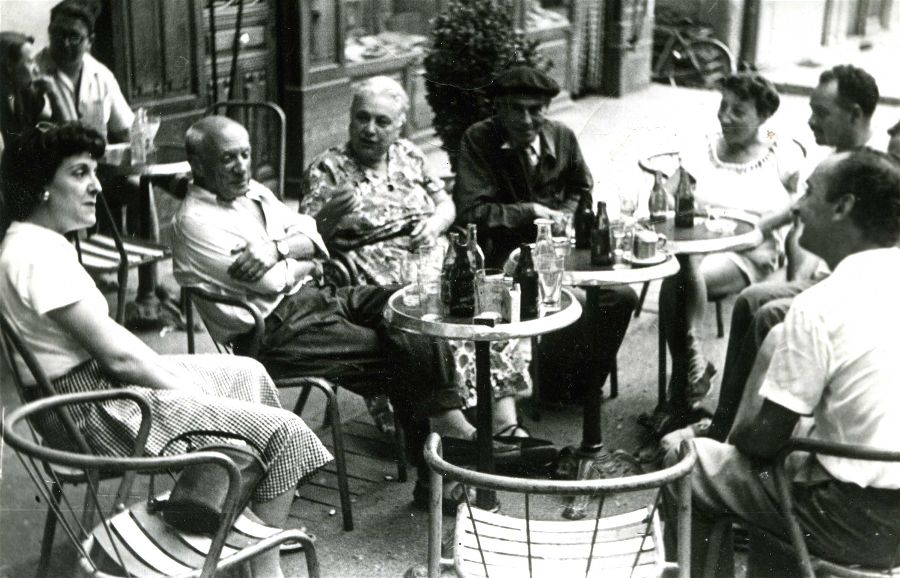What are you looking forward to in 2018?
What I’m most looking forward to is our trip to Picasso’s Pyrenees from May 19 to May 27. We'll follow in the footsteps of Picasso, Braque, Gris, Matisse, Maillol, and Dalí, among the many other artists who visited and worked in the villages of the Eastern Pyrenees along the Mediterranean coast: Céret, Collioure, Banyuls, and Perpignan. This region is rich not only in physical beauty but also in long-standing traditions of Catalonian music and dance, which attracted the artists in the first place.
Picasso at the Grand Café in Céret on the occasion of the opening of the Modern Art Museum. Courtesy Michel-Georges Bernard, Wikimedia Commons.
The Cherry Festival in Céret. (Click for video.)
Our trip also coincides with Céret’s Cherry Festival (not a coincidence), one of many festivals hosted by the party-loving Céretans. Céret has the earliest cherries in France due to its delightful micro-climate, nestled as it is on the south-eastern slopes of the Pyrenees. The first cherries from Céret are sent to the President of France. On offer are cherry wine, cherry beer, cherry pie, cherry clafoutis, cherry cheese, cherry – well, you get the idea. And the fun-loving Céretans also put on a cherry pitting contest and a cherry spitting contest.
Cherry spitting contest in progress at the Pinyodrome in Céret during the Cherry Festival.
The traditional brass and woodwind bands parade in the streets and compete with each other for prizes. There are two types: bandas and coblas. Bandas tend to have more brass and even some stringed instruments; coblas have more woodwinds, including elongated clarinet-like instruments with a nasal sound and a tiny fife and drum set. Coblas have existed for centuries in Céret and were one of the reasons that the composer Déodat de Sévérac, a friend of Picasso’s, came to Céret in the first place. The bandas are more like marching bands and play international as well as traditional tunes, always keeping up with the times while maintaining a strong tie to their past.
Traditional coblas playing for Sardane dancers in Céret.
Catalonian dancers also show off their skills in dancing many traditional dances, including the famous Sardane, immortalized by Picasso in his drawing “La Sardane de La Paix,” drawn right in the Grand Café in Céret on the occasion of the opening of its Museum of Modern Art. “La Sardane de La Paix” is now on view at the museum, as well as works by the other artists who passed through Céret, including Braque, Gris, Soutine, Dufy, Auguste Herbin, Matisse, and Miró, among many others.
Catalonian folk dance by Le ballet Joventut de Perpignan.
Dancers depicted on the Fountain of the Nine Spouts in Céret performing a line dance similar to the one in the clip above.
Singing also has a rich tradition in Céret and the rest of Catalonia. One of the most beautiful Christmas carols, "Fum, fum, fum," is Catalonian in origin. At Easter time, the Céretans sing Els Goigs dels Ous, "Happy Eggs," while going from house to house in a tradition dating back to the 12th Century. In the 16th century, popular songs were incorporated into the goigs, which provided additional themes to the traditionally Christian ones.
Céretans singing goigs dels ous in Céret at Easter.
There is so much more to say, see, and hear about Céret and French Catalonia that I can't possibly fit it all in here. I've designed our immersive, interactive Picasso's Pyrenees Tour from May 19-27 so I can share all the artistic glories of French Catalonia with you. Walk in the footsteps of Picasso, Braque, Gris, Matisse, Derain, Maillol, and Dalí, and experience the varied landscapes of the Eastern Pyrenees that brought them together and inspired them. Spots are limited to 12. Reserve by January 15 and save $290 off the regular price.
If Paris is more your style, our Papa's Paris Tour follows in Hemingway's footsteps as we meander through the city of art and romance from June 16-24. Spots are also limited to 12 so reserve yours now and save $320 off the regular price.
I'll leave you with this thrilling rendition of "Fum, Fum, Fum," which I guarantee you'll be humming the rest of the day.
"Fum, Fum, Fum," traditional Catalonian Christmas carol, performed by the Cor Jove de l'Orfeó Català.



